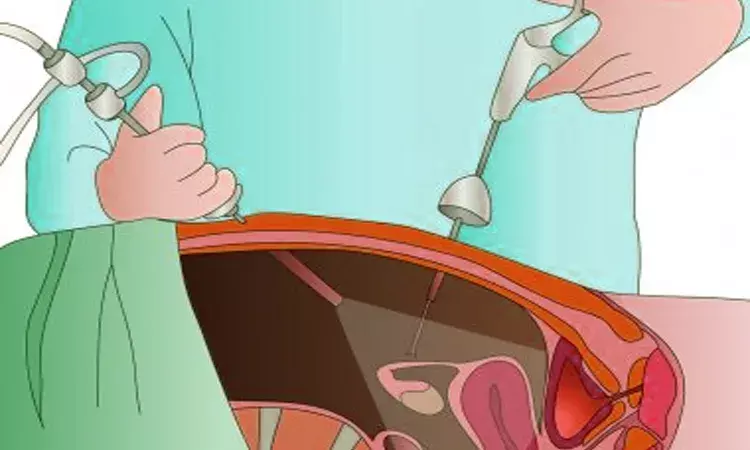- Home
- Medical news & Guidelines
- Anesthesiology
- Cardiology and CTVS
- Critical Care
- Dentistry
- Dermatology
- Diabetes and Endocrinology
- ENT
- Gastroenterology
- Medicine
- Nephrology
- Neurology
- Obstretics-Gynaecology
- Oncology
- Ophthalmology
- Orthopaedics
- Pediatrics-Neonatology
- Psychiatry
- Pulmonology
- Radiology
- Surgery
- Urology
- Laboratory Medicine
- Diet
- Nursing
- Paramedical
- Physiotherapy
- Health news
- Fact Check
- Bone Health Fact Check
- Brain Health Fact Check
- Cancer Related Fact Check
- Child Care Fact Check
- Dental and oral health fact check
- Diabetes and metabolic health fact check
- Diet and Nutrition Fact Check
- Eye and ENT Care Fact Check
- Fitness fact check
- Gut health fact check
- Heart health fact check
- Kidney health fact check
- Medical education fact check
- Men's health fact check
- Respiratory fact check
- Skin and hair care fact check
- Vaccine and Immunization fact check
- Women's health fact check
- AYUSH
- State News
- Andaman and Nicobar Islands
- Andhra Pradesh
- Arunachal Pradesh
- Assam
- Bihar
- Chandigarh
- Chattisgarh
- Dadra and Nagar Haveli
- Daman and Diu
- Delhi
- Goa
- Gujarat
- Haryana
- Himachal Pradesh
- Jammu & Kashmir
- Jharkhand
- Karnataka
- Kerala
- Ladakh
- Lakshadweep
- Madhya Pradesh
- Maharashtra
- Manipur
- Meghalaya
- Mizoram
- Nagaland
- Odisha
- Puducherry
- Punjab
- Rajasthan
- Sikkim
- Tamil Nadu
- Telangana
- Tripura
- Uttar Pradesh
- Uttrakhand
- West Bengal
- Medical Education
- Industry
Pregnancy rates after surgical sterilization higher than expected: Study

USA: A recent study published in the journal Fertility and Sterility showed that the pregnancy rates after female sterilization are considerably higher than expected, regardless of the sterilization procedure performed (hysteroscopically or laparoscopically). The findings are reassuring that the effectiveness of hysteroscopic sterilization is not inferior to laparoscopic sterilization.
Aileen M. Gariepy, Department of Obstetrics, Gynecology and Reproductive Sciences, Yale University School of Medicine, New Haven, Connecticut, and the team aimed to compare the real-world effectiveness of hysteroscopic and laparoscopic sterilization.
This retrospective cohort included women of age 18 to 50 years and was based on the Medicaid claims for hysteroscopic (5,906) or laparoscopic (23,965) sterilization procedures performed all over California, from 2008 to 2014. Postpartum procedures were excluded and regression models for clustered person-period data, weighted for propensity to receive either (Hysteroscopic or laparoscopic) procedures, sociodemographic and clinical variables to examine the post-sterilization pregnancy rates were applied. Post-sterilization pregnancy was measured by pregnancy-related claims.
Study highlights are as follows:
- A total of post-sterilization pregnancy claims were identified for 4.74% of women after hysteroscopic sterilization and 5.57% after laparoscopic sterilization. The pregnancy rates decreased overtime after both the procedures.
- The crude incidence of pregnancy claims was higher for hysteroscopic sterilization than for laparoscopic sterilization after a yea of the procedure (3.26:2.61 per 100 woman-years)
- Between 13 and 24 months after the procedure, Fewer pregnancies for women after hysteroscopic sterilizations were observed than for those after laparoscopic sterilizations by 13 to 24 months, with no statistical differences in later years.
- The cumulative pregnancy rates 5 years after sterilization were lower with hysteroscopic sterilization than with laparoscopic sterilization (6.26:7.22 per 100 woman-years; propensity-weighted, adjusted risk ratio, 0.76).
By the end of the study, the authors concluded that the findings reassure hysteroscopic sterilization was not inferior to laparoscopic sterilization.
Reference:
Gariepy, A. M., Lewis, C., Zuckerman, D., Tancredi, D. J., Murphy, E., McDonald-Mosley, R., Sonalkar, S., Hathaway, M., Nunez-Eddy, C., & Schwarz, E. B. (2022). Comparative effectiveness of hysteroscopic and laparoscopic sterilization for women: a retrospective cohort study. In Fertility and Sterility. Elsevier BV. https://doi.org/10.1016/j.fertnstert.2022.03.001
Medical Dialogues consists of a team of passionate medical/scientific writers, led by doctors and healthcare researchers. Our team efforts to bring you updated and timely news about the important happenings of the medical and healthcare sector. Our editorial team can be reached at editorial@medicaldialogues.in.
Dr Kamal Kant Kohli-MBBS, DTCD- a chest specialist with more than 30 years of practice and a flair for writing clinical articles, Dr Kamal Kant Kohli joined Medical Dialogues as a Chief Editor of Medical News. Besides writing articles, as an editor, he proofreads and verifies all the medical content published on Medical Dialogues including those coming from journals, studies,medical conferences,guidelines etc. Email: drkohli@medicaldialogues.in. Contact no. 011-43720751


